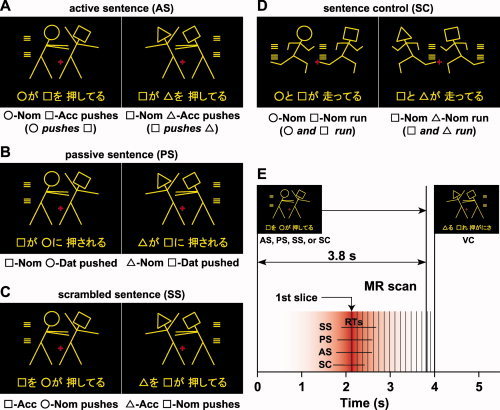Figure 1.

The four sentence conditions used in the picture‐sentence matching task and the timing of slice acquisition. Each stimulus consisted of one picture (top) and one sentence (bottom). Pictures depicting actions consisted of two stick figures, and each stick figure was distinguished by one of three “head” symbols: a circle (○), a square (□), or a triangle (▵). The participants judged whether or not the meaning of each sentence matched the action scene given in the corresponding picture. Two samples are shown for each condition. A: Under the active sentence (AS) condition, canonical/subject‐initial active sentences were presented (left, “○‐ga □‐o oshiteru”; right, “□‐ga ▵‐o oshiteru”). Below each example, a word‐by‐word translation in English is shown. Nom, nominative case; Acc, accusative case; Dat, dative case. See Table I for the stimulus list. B: Under the passive sentence (PS) condition, noncanonical/subject‐initial passive sentences were presented (left, “□‐ga ○‐ni osareru”; right, “▵‐ga □‐ni osareru”). C: Under the scrambled sentence (SS) condition, noncanonical/object‐initial scrambled sentences were presented (left, “□‐o ○‐ga oshiteru”; right, “▵‐o □‐ga oshiteru”). The sentence stimuli were all grammatical and commonly used in Japanese. An identical picture set was used under the AS, PS, and SS conditions. D: Under the sentence control (SC) condition, canonical/subject‐initial active sentences with two agents and one verb were presented (left, “○‐to □‐ga hashitteru”; right, “□‐to ▵‐ga hashitteru”). E: Each stimulus pair was presented for 3,800 ms with 200‐ms interstimulus intervals. The trial events of the picture‐sentence matching task occurred with variable intertrial intervals, in which four, five, or six visual control (VC) trials were presented. The first slice acquisition occurred 2,100 ms after the stimulus onset, and the acquisition timing of each slice was corrected using the first slice as a reference for the functional imaging data. A red‐graded bar schematically denotes a canonical homodynamic response function centered on the first slice (90% sensitivity at ±1 s). The range of RTs (mean ± SD) is also shown under each of the SC, AS, PS, and SS conditions.
